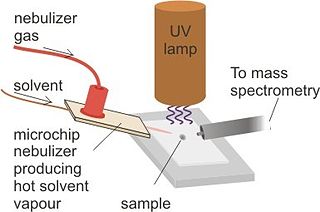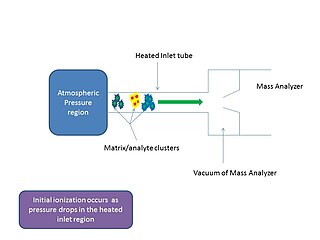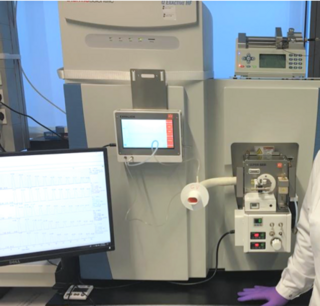Related Research Articles

Holography is a technique that enables a wavefront to be recorded and later re-constructed. Holography is best known as a method of generating real three-dimensional images, but it also has a wide range of other applications. In principle, it is possible to make a hologram for any type of wave.
Nanosensors are nanoscale devices that measure physical quantities and convert these to signals that can be detected and analyzed. There are several ways proposed today to make nanosensors; these include top-down lithography, bottom-up assembly, and molecular self-assembly. There are different types of nanosensors in the market and in development for various applications, most notably in defense, environmental, and healthcare industries. These sensors share the same basic workflow: a selective binding of an analyte, signal generation from the interaction of the nanosensor with the bio-element, and processing of the signal into useful metrics.

In mass spectrometry, matrix-assisted laser desorption/ionization (MALDI) is an ionization technique that uses a laser energy-absorbing matrix to create ions from large molecules with minimal fragmentation. It has been applied to the analysis of biomolecules and various organic molecules, which tend to be fragile and fragment when ionized by more conventional ionization methods. It is similar in character to electrospray ionization (ESI) in that both techniques are relatively soft ways of obtaining ions of large molecules in the gas phase, though MALDI typically produces far fewer multi-charged ions.
A holographic grating is a type of diffraction grating formed by an interference-fringe field of two laser beams whose standing-wave pattern is exposed to a set of photosensitive materials. The exposure triggers chemical processes within the sample and results in the formation of a periodic structure that has the same periodicity of the recorded pattern. One of the most interesting features of these structures is their versatility and tunability as the optical response strongly depends on the blend of used materials, and their interactions with light during, and after, the recording procedure.
A gas detector is a device that detects the presence of gases in an area, often as part of a safety system. A gas detector can sound an alarm to operators in the area where the leak is occurring, giving them the opportunity to leave. This type of device is important because there are many gases that can be harmful to organic life, such as humans or animals.

Desorption atmospheric pressure photoionization (DAPPI) is an ambient ionization technique for mass spectrometry that uses hot solvent vapor for desorption in conjunction with photoionization. Ambient Ionization techniques allow for direct analysis of samples without pretreatment. The direct analysis technique, such as DAPPI, eliminates the extraction steps seen in most nontraditional samples. DAPPI can be used to analyze bulkier samples, such as, tablets, powders, resins, plants, and tissues. The first step of this technique utilizes a jet of hot solvent vapor. The hot jet thermally desorbs the sample from a surface. The vaporized sample is then ionized by the vacuum ultraviolet light and consequently sampled into a mass spectrometer. DAPPI can detect a range of both polar and non-polar compounds, but is most sensitive when analyzing neutral or non-polar compounds. This technique also offers a selective and soft ionization for highly conjugated compounds.

Ambient ionization is a form of ionization in which ions are formed in an ion source outside the mass spectrometer without sample preparation or separation. Ions can be formed by extraction into charged electrospray droplets, thermally desorbed and ionized by chemical ionization, or laser desorbed or ablated and post-ionized before they enter the mass spectrometer.

Laser ablation electrospray ionization (LAESI) is an ambient ionization method for mass spectrometry that combines laser ablation from a mid-infrared (mid-IR) laser with a secondary electrospray ionization (ESI) process. The mid-IR laser is used to generate gas phase particles which are then ionized through interactions with charged droplets from the ESI source. LAESI was developed in Professor Akos Vertes lab by Dr. Peter Nemes in 2007 and it was marketed commercially by Protea Biosciences, Inc until 2017. Fiber-LAESI for single-cell analysis approach was developed by Dr. Bindesh Shrestha in Professor Vertes lab in 2009. LAESI is a novel ionization source for mass spectrometry (MS) that has been used to perform MS imaging of plants, tissues, cell pellets, and even single cells. In addition, LAESI has been used to analyze historic documents and untreated biofluids such as urine and blood. The technique of LAESI is performed at atmospheric pressure and therefore overcomes many of the obstacles of traditional MS techniques, including extensive and invasive sample preparation steps and the use of high vacuum. Because molecules and aerosols are ionized by interacting with an electrospray plume, LAESI's ionization mechanism is similar to SESI and EESI techniques.

A localized surface plasmon (LSP) is the result of the confinement of a surface plasmon in a nanoparticle of size comparable to or smaller than the wavelength of light used to excite the plasmon. When a small spherical metallic nanoparticle is irradiated by light, the oscillating electric field causes the conduction electrons to oscillate coherently. When the electron cloud is displaced relative to its original position, a restoring force arises from Coulombic attraction between electrons and nuclei. This force causes the electron cloud to oscillate. The oscillation frequency is determined by the density of electrons, the effective electron mass, and the size and shape of the charge distribution. The LSP has two important effects: electric fields near the particle's surface are greatly enhanced and the particle's optical absorption has a maximum at the plasmon resonant frequency. Surface plasmon resonance can also be tuned based on the shape of the nanoparticle. The plasmon frequency can be related to the metal dielectric constant. The enhancement falls off quickly with distance from the surface and, for noble metal nanoparticles, the resonance occurs at visible wavelengths. Localized surface plasmon resonance creates brilliant colors in metal colloidal solutions.

Organic photonics includes the generation, emission, transmission, modulation, signal processing, switching, amplification, and detection/sensing of light, using organic optical materials.

Michael (Mickey) Barber, FRS was a British chemist and mass spectrometrist, best known for his invention of fast atom bombardment ionisation.

Atmospheric pressure photoionization (APPI) is a soft ionization method used in mass spectrometry (MS) usually coupled to liquid chromatography (LC). Molecules are ionized using a vacuum ultraviolet (VUV) light source operating at atmospheric pressure, either by direct absorption followed by electron ejection or through ionization of a dopant molecule that leads to chemical ionization of target molecules. The sample is usually a solvent spray that is vaporized by nebulization and heat. The benefit of APPI is that it ionizes molecules across a broad range of polarity and is particularly useful for ionization of low polarity molecules for which other popular ionization methods such as electrospray ionization (ESI) and atmospheric pressure chemical ionization (APCI) are less suitable. It is also less prone to ion suppression and matrix effects compared to ESI and APCI and typically has a wide linear dynamic range. The application of APPI with LC/MS is commonly used for analysis of petroleum compounds, pesticides, steroids, and drug metabolites lacking polar functional groups and is being extensively deployed for ambient ionization particularly for explosives detection in security applications.

Desorption/ionization on silicon (DIOS) is a soft laser desorption method used to generate gas-phase ions for mass spectrometry analysis. DIOS is considered the first surface-based surface-assisted laser desorption/ionization (SALDI-MS) approach. Prior approaches were accomplished using nanoparticles in a matrix of glycerol, while DIOS is a matrix-free technique in which a sample is deposited on a nanostructured surface and the sample desorbed directly from the nanostructured surface through the adsorption of laser light energy. DIOS has been used to analyze organic molecules, metabolites, biomolecules and peptides, and, ultimately, to image tissues and cells.

In mass spectrometry, matrix-assisted ionization is a low fragmentation (soft) ionization technique which involves the transfer of particles of the analyte and matrix sample from atmospheric pressure (AP) to the heated inlet tube connecting the AP region to the vacuum of the mass analyzer.

A copper nanoparticle is a copper based particle 1 to 100 nm in size. Like many other forms of nanoparticles, a copper nanoparticle can be prepared by natural processes or through chemical synthesis. These nanoparticles are of particular interest due to their historical application as coloring agents and the biomedical as well as the antimicrobial ones.
Jennifer S. Brodbelt is an American chemist known for her research using mass spectrometry to characterize organic compounds, especially biopolymers and proteins.
Christa L. Brosseau is a Canadian chemist, currently a Canada Research Chair at Saint Mary's University (Halifax). Brosseau's research focus is on Electrochemical Surface-Enhanced Raman Spectroscopy.

Secondary electro-spray ionization (SESI) is an ambient ionization technique for the analysis of trace concentrations of vapors, where a nano-electrospray produces charging agents that collide with the analyte molecules directly in gas-phase. In the subsequent reaction, the charge is transferred and vapors get ionized, most molecules get protonated and deprotonated. SESI works in combination with mass spectrometry or ion-mobility spectrometry.
Focal molography is a biophysical method for robust and sensitive detection of biomolecular interactions in a label-free manner. The new method enables biomolecular interaction analysis in complex biological samples without the use of additional fluorescent labels. Molography widens the analytic scope of biomolecular interaction analysis techniques in a broad range of applications, e.g. label-free trace analysis of a targeted molecule in complex samples, such as blood sera, bioreactor fluid or cell culture media. Contrary to refractometric methods for label-free biomolecular interaction analysis, such as surface plasmon resonance (SPR) and reflectometric interference spectroscopy (RIfS), molography allows quantification of molecular interactions in living cells in real time.
B. Jill Venton is a professor of chemistry at University of Virginia, where she serves as the department chair since 2019. Venton's research focuses on developing analytical chemistry methods to enable detection of molecules in the brain.
References
- ↑ AK Yetisen; I Naydenova; F da Cruz Vasconcellos; J Blyth; CR Lowe (2014). "Holographic Sensors: Three-Dimensional Analyte-Sensitive Nanostructures and their Applications". Chemical Reviews. 114 (20): 10654–96. doi: 10.1021/cr500116a . PMID 25211200.
- ↑ AK Yetisen; Y Montelongo; FC Vasconcellos; JL Martinez-Hurtado; S Neupane; H Butt; MM Qasim; J Blyth; K Burling; JB Carmody; M Evans; TD Wilkinson; LT Kubota; MJ Monteiro; CR Lowe (2014). "Reusable, Robust, and Accurate Laser-Generated Photonic Nanosensor". Nano Letters. 14 (6): 3587–3593. Bibcode:2014NanoL..14.3587Y. doi: 10.1021/nl5012504 . PMID 24844116.
- ↑ AK Yetisen; H Butt; F da Cruz Vasconcellos; Y Montelongo; CAB Davidson; J Blyth; JB Carmody; S Vignolini; U Steiner; JJ Baumberg; TD Wilkinson; CR Lowe (2014). "Light-Directed Writing of Chemically Tunable Narrow-Band Holographic Sensors". Advanced Optical Materials. 2 (3): 250–254. doi:10.1002/adom.201300375. S2CID 96257175.
- ↑ FC Vasconcellos; AK Yetisen; Y Montelongo; H Butt; A Grigore; CAB Davidson; J Blyth; MJ Monteiro; TD Wilkinson; CR Lowe (2014). "Printable Surface Holograms via Laser Ablation" (PDF). ACS Photonics. 1 (6): 489–495. doi:10.1021/ph400149m.
- ↑ Hurtado, J. L. Martinez; Lowe, C. R. (2014). "Ammonia-Sensitive Photonic Structures Fabricated in Nafion Membranes by Laser Ablation". ACS Applied Materials & Interfaces. 6 (11): 8903–8908. doi:10.1021/am5016588. ISSN 1944-8244. PMID 24803236.
- ↑ CP Tsangarides; AK Yetisen; FC Vasconcellos; Y Montelongo; MM Qasim; CR Lowe; TD Wilkinson; H Butt (2014). "Computational modelling and characterisation of nanoparticle-based tuneable photonic crystal sensors" (PDF). RSC Advances. 4 (21): 10454–10461. Bibcode:2014RSCAd...410454T. doi:10.1039/C3RA47984F. S2CID 15441587.
- 1 2 Martínez-Hurtado, J. L.; Davidson, C. A. B.; Blyth, J.; Lowe, C. R. (2010). "Holographic Detection of Hydrocarbon Gases and Other Volatile Organic Compounds". Langmuir. 26 (19): 15694–15699. doi:10.1021/la102693m. ISSN 0743-7463. PMID 20836549.
- ↑ Selective Holographic Glucose Sensor: http://ieeexplore.ieee.org/stamp/stamp.jsp?tp=&arnumber=1426342&userType=inst
- ↑ Blyth, Jeff; Millington, Roger B.; Mayes, Andrew G.; Frears, Emma R.; Lowe, Christopher R. (1996). "Holographic Sensor for Water in Solvents". Analytical Chemistry. 68 (7): 1089–1094. doi:10.1021/ac9509115. ISSN 0003-2700. PMID 21619138.
- ↑ Sartain, Felicity K.; Yang, Xiaoping; Lowe, Christopher R. (2006). "Holographic Lactate Sensor". Analytical Chemistry. 78 (16): 5664–5670. doi:10.1021/ac060416g. ISSN 0003-2700. PMID 16906709.
- ↑ Marshall, Alexander J.; Young, Duncan S.; Blyth, Jeff; Kabilan, Satyamoorthy; Lowe, Christopher R. (2004). "Metabolite-Sensitive Holographic Biosensors". Analytical Chemistry. 76 (5): 1518–1523. doi:10.1021/ac030357w. ISSN 0003-2700. PMID 14987112.
- ↑ Millington, Roger B.; Mayes, Andrew G.; Blyth, Jeff.; Lowe, Christopher R. (1995). "A Holographic Sensor for Proteases". Analytical Chemistry. 67 (23): 4229–4233. doi:10.1021/ac00119a004. ISSN 0003-2700.
- ↑ AK Yetisen; M Qasim; S Nosheen; TD Wilkinson; CR Lowe (2014). "Pulsed laser writing of holographic nanosensors". Journal of Materials Chemistry C. 2 (18): 3569. doi:10.1039/C3TC32507E.